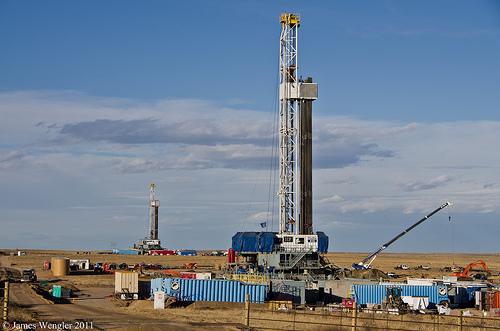The Fracturing Truth of Fracking

A picture of a Hydraulic Fracturing Well.
The burning of oil and coal to extract natural gasses from under the earth’s surface has been no more than routine since its beginning. Hydraulic Fracturing or fracking has been the new thing to do for many reasons and has exploded in popularity in the United States over the past 15 years despite causing more controversy than originally expected. But still generating a 41 to 48 percent support rate.
Fracking is drilling vertically into the ground using fracking wells. Fracking wells cut more than a mile under our feet using a high powered drill that drills into the shale rock where pockets of natural gas lie. Using fracking to extract natural requires a lubrican for the drill to drill properly. The chemical mixture is a concoction of water, sand, and an uncountable amount of chemicals.
By now, more than one third of the natural gas extracted in the U.S. is done so by fracking. Carbon emissions have fallen in the U.S as a result. Fracking is even cheaper than our old fashion methods of extracting natural gas; it is thought to be the bridge between Carbon based energy of the past and the cleaner and greener methods of the future. Why then has Vermont been the first state to ban fracking.
4:30 pm Gov. Peter Shumlin of Vermont signed a statewide ban on fracking on May 16, 2012. As the dangers of fracking have become more accessible to the public, other states such as Hawaii and Wisconsin have followed suit. Air and water pollutants are results of fracking but with any industrial activity that is the norm. However, a suspicious amount of minor earthquakes have been linked back to fracking. For the icing on the cake, the concoction of chemicals blasted into the ground prevents buildup of bacteria and microorganisms in the pipes which cause clogging. The mixture is lethal to other life organisms so it would make sense that 650 of the chemicals used are known to cause cancer in people. This would be fine for some if the chemicals stayed where they were left. However, the chemicals are not dormant: seeping their way into underground water deposits’, which happen to be used for drinking water. Methane gas is a byproduct of fracking, and again, methane is not dormant. Finding leeks in the fracking wells, wellheads and blowouts to creep into our air. It is true, as a result of fracking carbon emissions are down. But methane will trap 72 times the amount of heat that carbon dioxide will over the next 20 years. And that is quite a big number.
Since fracking is new, laws have not been passed to correctly regulate fracking. Current laws like the Safe Drinking Water Act and the Clean Water Act have too many loopholes that are being utilized. For instance, the Clean Water Act permits temporary stored waste from fracking facilities to go untreated. It is now estimated that 250 billion cubic meters of natural gas is brought to our surface from fracking in the U.S. alone.
The long-term effects of fracking are still unknown to us and yet it is growing more rapidly than ever. Preventing more damage than we have already caused we need to educate our audience so states can decide whether a cheaper way of extracting natural gasses is a fair trade for the cancer hazardous chemicals getting into our drinking water. Others seem to be catching on; tougher fracking regulations are backed by 66 percent, polls show.













